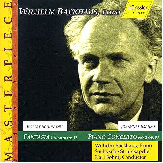Wilhelm Backhaus’ 1939 Brahms Second Concerto remains one of this oft-recorded work’s discographic high-points. The pianist negotiates each and every one of the composer’s cruel demands and never sweats a bead. Many pianists slow down to cope with the opening cadenza’s lardy chords and awkward leaps, or wrestle the taxing trills like Jacob against the Angel. Not Backhaus. He’s equally at home with the haunting slow movement’s long-lined introspection. The pianist’s supple fluidity in the Finale contrasts to his heavier-gaited playing in his mono and stereo LP-era remakes. No question that Backhaus’ clean, Apollonian artistry boasts far greater accuracy compared to the sloppier Rubinstein and Schnabel 78-rpm traversals.
True, you don’t get the ferocity and quaking unrest Horowitz brought to the piano part in his famous recording one year later, nor does Karl Böhm’s solid support match the dynamic range and tensile expression Toscanini drew from the NBC Orchestra (its string section totally outclasses its Dresden counterpart). But Backhaus enjoys superior sonics, and Hänssler’s remastering engineers obtain clean results from excellent source material. The bass is boosted, with high-end frequencies scaled down to ensure minimum surface noise. Similar restoration methods are used for Backhaus’ 1937 Schumann Fantasia, but to less convincing musical effect. You lose the ringing definition and overtones that are present in both the Pearl and Andante transfers, although again, some listeners might prefer Hänssler’s bass emphasis. Whatever transfer you choose, it’s hard not to be won over by Backhaus’ swift tempos, sweeping authority and directness, and ironclad yet flexible technique. Small wonder that this was the reference Schumann Fantasia of the shellac era, and its virtues hold their own to this day.
































